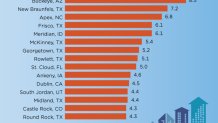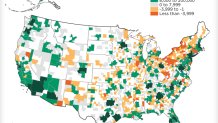The U.S. Census Bureau released it's population estimates for cities and towns Thursday and Texas (and North Texas) continues to dominate.
The census estimates U.S. population grew 6% between April 1, 2010 to July 1, 2018 to 327,167,434 residents. In Texas, the state population is now estimated to be 28,701,845, second only to California's 39,557,045. There are five states with a total population less than 1 million: Alaska (737,438), North Dakota (760,077), South Dakota (882,235), Vermont (626,299) and Wyoming (577,737).
The data obtained by the U.S. Census highlighted below is for July 1, 2017 to July 1, 2018, and considers only cities and towns with populations greater than 50,000 residents.
Several Texas cities were noted for population surges, including Austin (+12,504), Frisco (+10,884) and McKinney (+9,888). The incorporated towns of Leander (56,111), Little Elm (50,314) and Wylie (51,585) were highlighted for topping 50,000 residents.
Of the 15 fastest-growing cities, Texas cities and towns occupied seven of the spots. No. 1 went to Buckeye, Arizona (+8.5% increase/74,370 population), but No. 2 was New Braunfels (+7.2%/84,612) followed by No. 4 Frisco (+6.1%/188,170), No. 6 McKinney (+5.4%/191,645), No. 7 Georgetown (+5.2%/74,180), No. 8 Rowlett (+5.1%/66,285), No. 13 Midland (+4.4%/142,344) and No. 15 Round Rock (+4.3%/128,739).

There were five Texas cities with the largest numeric increase. Phoenix was No. 1 (+25,288 increase/1,660,272 population), but No. 2 was San Antonio (+20,824/1,532,233), No. 3 Fort Worth (+19,522/895,008), No. 6 Austin (+12,504/964,254), No. 10 Frisco (+10,884/188,170) and No. 13 McKinney (+9,888/191,645).
There were also five Texas cities among the 15 most populous. Fort Worth, which was previously ranked No. 15, surpassed San Francisco and Columbus and jumped to No. 13 on the list.
- No. 1 New York (8,398,748)
- No. 2 Los Angeles (3,990,456)
- No. 3 Chicago (2,705,994)
- No. 4 Houston (2,325,502)
- No. 5 Phoenix (1,660,272)
- No. 6 Philadelphia (1,584,138)
- No. 7 San Antonio (1,532,233)
- No. 8 San Diego (1,425,976)
- No. 9 Dallas (1,345,047)
- No. 10 San Jose (1,030,119)
- No. 11 Austin (964,254)
- No. 12 Jacksonville (903,889)
- No. 13 Fort Worth (895,008)
- No. 14 Columbus (892,533)
- No. 15 San Francisco (883,305)
The U.S. Census said that, by metropolitan statistical area, Dallas-Fort Worth-Arlington had the largest numeric growth from 2017-2018 with a gain of 131,767 (1.8%) residents followed by Phoenix-Mesa-Scottsdale with an increase of 96,268 (2%).
"Migration, both domestic and international, as well as natural increase (births) contributed to the growth in each of these areas, with natural increase serving as the largest source of population growth in Dallas and domestic migration serving as the largest source in Phoenix," the Census said.

The Dallas-Fort Worth-Arlington MSA remains the fourth largest Metropolitan area in the country.
- No. 1 New York-Newark-Jersey City (19,979,477)
- No. 2 Los Angeles-Long Beach-Anaheim (13,291,486)
- No. 3 Chicago-Naperville-Elgin (9,498,716)
- No. 4 Dallas-Fort Worth-Arlington (7,539,711), No. 1 growth +131,767
- No. 5 Houston-The Woodlands-Sugar Land (6,997,384), No. 3 growth +91,689
- No. 6 Washington-Arlington-Alexandria (6,249,950), No. 10 growth +49,949
- No. 7 Miami-Fort Lauderdale-West Palm Beach (6,198,782)
- No. 8 Philadelphia-Camden-Wilmington (6,096,372)
- No. 9 Atlanta-Sandy Springs-Roswell (5,949,951)
- No. 10 Boston-Cambridge-Newton (4,875,390)

